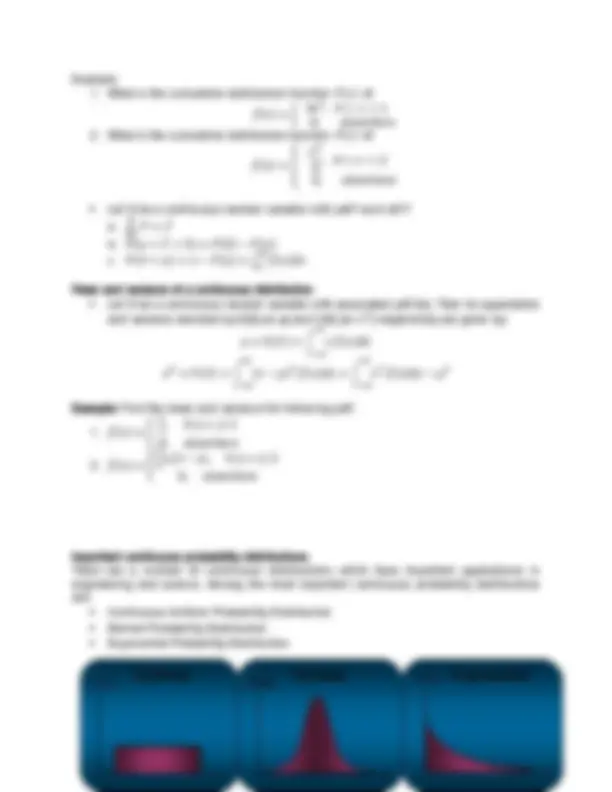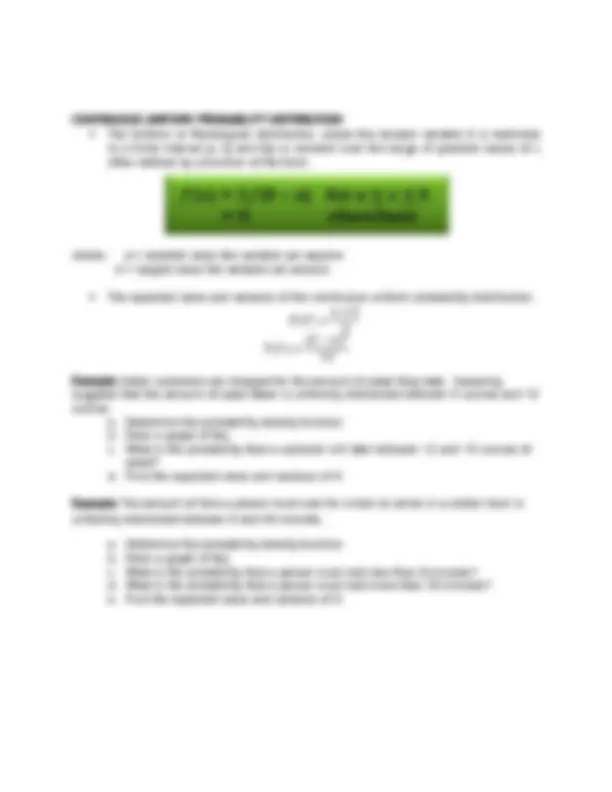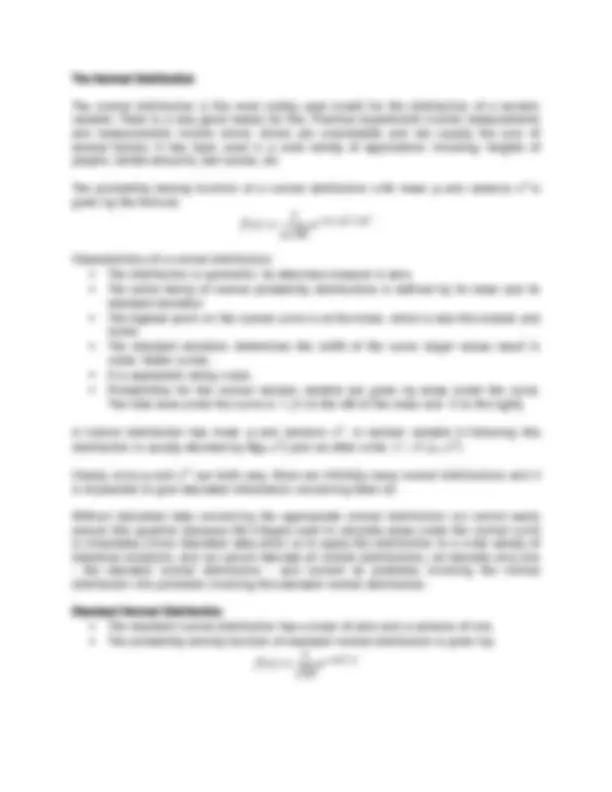





Study with the several resources on Docsity

Earn points by helping other students or get them with a premium plan


Prepare for your exams
Study with the several resources on Docsity

Earn points to download
Earn points by helping other students or get them with a premium plan
Community
Ask the community for help and clear up your study doubts
Discover the best universities in your country according to Docsity users
Free resources
Download our free guides on studying techniques, anxiety management strategies, and thesis advice from Docsity tutors
The concept of continuous probability distribution and probability density function. It also covers the cumulative distribution function and the normal distribution. examples and formulas to understand the concepts. It is important to have a good understanding of calculus skills of integration and differentiation to comprehend the content of the document.
Typology: Lecture notes
1 / 7

This page cannot be seen from the preview
Don't miss anything!




CC9 - Probability
In the previous section, we investigated probability distributions of discrete random
variables, that is, random variables whose sample space contains a countable number of
outcomes. In the discrete case, the number of outcomes in the sample space can be either
finite or countably infinite.
In this section, as the title suggests, we are going to investigate probability distributions of
continuous random variables, that is, random variables whose sample space contains an
infinite interval of possible outcomes.
Make sure your calculus skills of integration and differentiation are up to snuff.
Definition: Continuous Random Variable
number of possible values in a given interval. This contrasts with the definition of a
discrete random variable which can only assume discrete values.
a. Rainfall
b. Temperature
c. Weight in pounds
characterised or can be modelled, not by probabilities mass function 𝑃(𝑋 = 𝑥) (as
was the case with a discrete random variable), but by a function called the
probability density function (pdf for short).
variable assume a particular value, but only calculate the probability that it lies
within a given range of values say (𝑎, 𝑏), that is finding 𝑃(𝑎 < 𝑋 < 𝑏) , where a and
b are some constants.
Probability Density Function
support 𝑆 is an integrable function 𝑓(𝑥) satisfying the following:
∞
−∞
Example: Identify the following function whether it is a valid probability density function or
not.
𝑥
2
2
10
3
2
𝑥
3
4
Note:
✓ 𝑓(𝑥) represents the height of the curve at point x, thus 𝑓
✓ In continuous rv, it is the areas under the curve that define the probabilities.
✓ The probability the random variable X is exactly equal to any specific value is 0 that
is 𝑃(𝑥 = 𝑎) = 0. Thus 𝑃
Cumulative Distribution Function
as 𝐹(𝑥) = 𝑃(𝑋 ≤ 𝑥).
𝑥
− ∞
Properties of CDF
𝑥→−∞
𝑥→+∞
to a finite interval [a, b] and f(x) is constant over the range of possible values of x
often defined by a function of the form:
2
Example: Slater customers are charged for the amount of salad they take. Sampling
suggests that the amount of salad taken is uniformly distributed between 5 ounces and 15
ounces.
a. Determine the probability density function.
b. Draw a graph of f(x).
c. What is the probability that a customer will take between 12 and 15 ounces of
salad?
d. Find the expected value and variance of X.
Example: The amount of time a person must wait for a train to arrive in a certain town is
uniformly distributed between 0 and 40 minutes.
a. Determine the probability density function.
b. Draw a graph of f(x).
c. What is the probability that a person must wait less than 8 minutes?
d. What is the probability that a person must wait more than 30 minutes?
e. Find the expected value and variance of X.
The Normal Distribution
The normal distribution is the most widely used model for the distribution of a random
variable. There is a very good reason for this. Practical experiments involve measurements
and measurements involve errors. Errors are unavoidable and are usually the sum of
several factors. It has been used in a wide variety of applications including: heights of
people, rainfall amounts, test scores, etc.
The probability density function of a normal distribution with mean μ and variance 𝜎
2
is
given by the formula
−
( 𝑥−𝜇
)
2
/ 2 𝜎
2
Characteristics of a normal distribution:
standard deviation
mode.
wider, flatter curves.
The total area under the curve is 1 (.5 to the left of the mean and .5 to the right).
A normal distribution has mean μ and variance 𝜎
2
. A random variable X following this
distribution is usually denoted by N(μ, 𝜎
2
) and we often write 𝑋 ~ 𝑁 (𝜇 , 𝜎
2
Clearly, since μ and 𝜎
2
can both vary, there are infinitely many normal distributions and it
is impossible to give tabulated information concerning them all.
Without tabulated data concerning the appropriate normal distribution we cannot easily
answer this question (because the integral used to calculate areas under the normal curve
is intractable.) Since tabulated data allow us to apply the distribution to a wide variety of
statistical situations, and we cannot tabulate all normal distributions, we tabulate only one
distribution into problems involving the standard normal distribution.
Standard Normal Distribution
−
( 𝑥
)
2
/ 2
The Exponential Distribution
The exponential probability distribution is useful in describing the time it takes to
complete a task. The exponential distribution is a continuous distribution that is commonly
used to measure the expected time for an event to occur.
The time X we need to wait before an event occurs has an exponential distribution if the
probability that the event occurs during a certain time interval is proportional to the length
of that time interval.
The probability density function (pdf) of an exponential distribution is
−𝜆𝑥
The parameter 𝜆 is called the rate parameter. It is the inverse of the expected duration
(𝜇). Where 𝜇 is the average/mean.
The cumulative distribution function of an exponential distribution can be written as:
−𝜆𝑥
The expected value and variance of an exponential random variable X is given by:
2
2
Example:
exponential probability distribution with a mean time between arrivals of 3 minutes.
Al would like to know the probability that the time between two successive arrivals
will be 2 minutes or less.
X with parameter 𝜆 =
1
10
. If someone arrives at a phone booth just before you arrive,
find the probability that you will have to wait
a. Less than 5 minutes
b. Greater than 10 minutes
c. Between 5 and 10 minutes